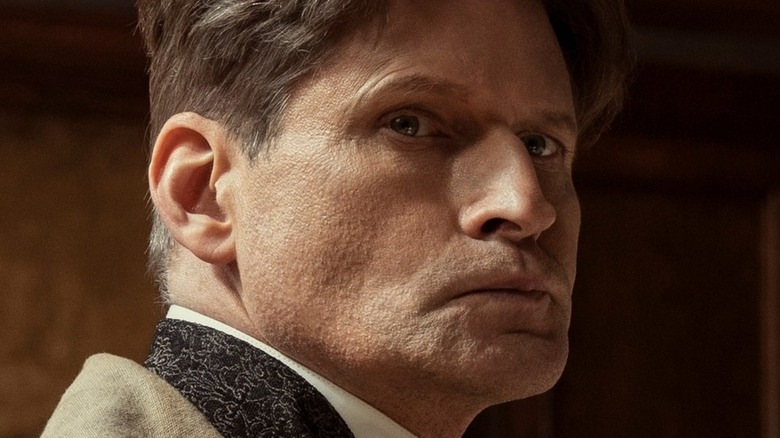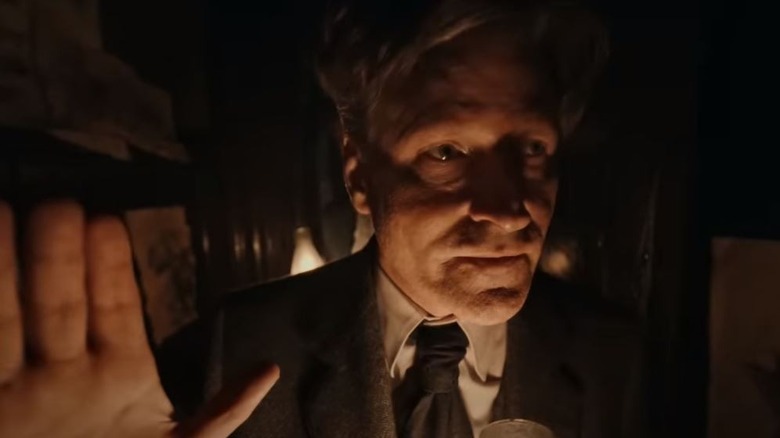Here's How Cabinet Of Curiosities Changed Lovecraft's Pickman's Model
Contains spoilers for "Guillermo del Toro's Cabinet of Curiosities" Episode 5, "Pickman's Model"
Every episode of "Guillermo del Toro's Cabinet of Curiosities" contains creepy moments, but some add an extra element of otherworldly terror by adapting the works of H.P. Lovecraft. "Pickman's Model," for instance, is a gothic horror adaptation of the writer's 1927 short story of the same name. The episode stars Ben Barnes as art student-turned-museum curator Will Thurber, and Crispin Glover as the titular, horrifyingly talented artist Richard Pickman.
In Lovecraft's tale, Pickman has recently disappeared, and Thurber recounts his story to a friend called Eliot over drinks. The friend is worried about Thurber, not least because the protagonist has developed a strange fear of underground places. Of course, the fear's not quite as unreasonable as Eliot is implied to assume. It stems from an unnerving visit to Pickman's secret basement studio in a shady old part of Boston, which made Thurber realize the horrific secret behind Pickman's art. Instead of using his imagination to create his terrifying paintings, the artist simply uses real, ghoulish, underground-dwelling "dog-thing" monsters as his inspiration.
The Netflix version follows the short story's basic premise. However, "Cabinet of Curiosities" adds quite a bit of flesh around the comparatively barebones narrative of the original, changing key details and expanding the story in several places. Here's a look at how Netflix's "Cabinet of Curiosities" changed Lovecraft's "Pickman's Model."
Pickman's fate is very different in the original
The most significant difference between the episode and the source material is probably Robert Pickman's true nature and his ultimate fate. In "Cabinet of Curiosities," the tormented Thurber attempts to rid the world of Pickman and his paintings by burning the artworks and accidentally killing the man himself. As he nears death, Pickman reveals that he's been painting real scenes of present and future, before a monstrous entity takes his mortal remains away. As for the paintings, they find themselves to Thurber's museum unharmed, and wreak havoc on the minds of the people who view them.
In the short story, Pickman hasn't been a vessel of grim forces per se, but an artist who simply paints what fascinates him. However, there's a different unnerving twist that implies the guy's true nature. The narrative drops numerous hints that Pickman isn't quite human. Thurber doesn't quite connect the dots himself, but one painting about a changeling baby that heavily resembles Pickman suggests that the artist might actually be a ghoul that passes for a human.
Though it's not explicitly stated in the short story, Pickman also survives the events of the plot. While the artist has disappeared by the time the story is told, Thurber is too shaken for lengthy speculation about his ultimate fate. A later Lovecraft novella, "The Dream-Quest of Unknown Kadath," confirms that Pickman is indeed alive and well by having the artist make an appearance — this time, transformed to his full ghoulish glory.
Different versions, different monsters
Both versions of Pickman have a degree of access to the paranormal world, and a family history that seems to enable said access. However, the "Cabinet of Curiosities" Pickman has a much more ominous role in the grander scheme of things. Instead of a mere inherited fascination with one particular monster-species and the dark things that are in their nature, he seems to be a very real harbringer of the apocalypse, and may even be eyeing Thurber as his successor. What's more, the Netflix Pickman's paintings are far more than simple documentation of the ghoul creatures and their antics. The "Cabinet of Curiosities" artist's paintings are supernatural in nature, as even burning them does little to erase them from existence.
The "Cabinet of Curiosities" version of "Pickman's Model" shows that the artist's paintings often depict demonic entities and grim, surreal scenery that turns out to be prophetic. In fact, his family history and body of work seem to build toward the apocalyptic rise of a Great Old One. The adaptation features numerous elements from the wider Lovecraft mythos, as opposed to the much tighter focus of the original story.
Meanwhile, the short story's only monsters are the ghouls Thurber calls "dog-things." Despite their horrific appearance and tendency to eat people and corpses, they're actually far more mellow than Lovecraft's usual cadre of eldrich terrors, and the writer even creates a fairly intricate social structure for them. Descriptions of the ghouls' unnerving habits, origins, diet, and rudimentary culture all unfold through Thurber's interpretations of Pickman's paintings.
In Lovecraft's later work, "The Dream-Quest of Unknown Kadath," Pickman's particular horde of ghouls even turns out to be quite friendly with the protagonist. This pretty much makes them the rarest of Lovecraft creatures: a monster that can be perfectly cool with humans, at least provided it isn't hungry.
Some plotlines are exclusive to the Netflix adaptation
Though extremely disturbing, Pickman's paintings in the original short story aren't exactly madness-inducing, unless you count the way they routinely offend others. The artist's work might be nauseating, but at the end of the day, he's simply an extremely talented photorealistic painter who has the benefit of using real monsters — or photographs of them — as his models. In "Cabinet of Curiosities," however, Pickman's paintings have a much stranger nature. Not only can they survive a fire, but they seem to directly affect the minds of viewers ... like Thurber's wife, Rebecca (Oriana Leman).
Speaking of Rebecca and her role in the episode's dramatic twist ending, she's entirely absent from the original story, in which Lovecraft never as much as mentions Thurber's marital status. As such, all events that involve the Thurber family are exclusive to the "Cabinet of Curiosities."
The themes of the "Pickman's Model" short story are somewhat removed from the grander Lovecraft mythos, so it's not exactly surprising that "Cabinet of Curiosities" takes certain liberties to expand the plot toward large-scale destruction instead of focusing on a single type of underground-dwelling monster. After all, "Pickman's Model" has already been adapted several times in various forms and degrees of accuracy — and "Cabinet of Curiosities" already tells a highly effective subterranean monster story in Episode 2, "Graveyard Rats."



